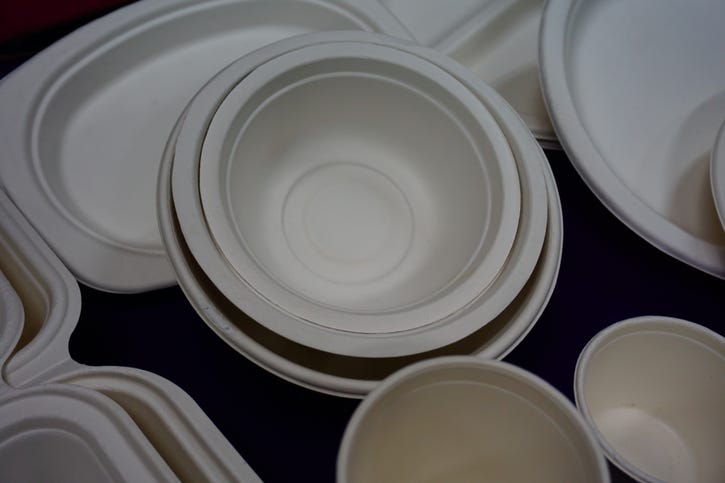WestRock Accepting Foodservice Packaging at Paper Mills
These products are taking their toll on landfills, with few MRFs equipped to manage them, even though they contain desired, quality fiber.

WestRock is accepting wasted foodservice packaging at eight paper mills with plans to expand this effort. These fast-accumulating, single-use products are taking their toll on landfills, with few materials recovery facilities (MRFs) equipped to manage them, even though they contain desired, quality fiber.
Packaging, largely foodservice packaging, makes up 23 percent of landfill content, according to the U.S. Environmental Protection Agency. That’s a lot of wasted material—this packaging is about 90 percent fiber.
But there are two primary challenges with poly-coated packaging. Its plastic content must be separated from paper. Second, there’s the question: is there enough material by specific product type to make it worth sorting?
Partnering with the Foodservice Packaging Institute (FPI), WestRock did residential collections in Chattanooga, Tenn., and in Louisville, Ky., where foodservice packaging was sorted at MRFs and then sent to WestRock mills for processing.
It also conducted a similar trial at a Saint Paul, Minn., paper mill using sheets of cup stock that went into the pulper.
“We make paper board, so it was easy to get that material and have it sheeted for the trial, which was successful,” says Rhea Hale, director of public policy for WestRock Company.
The company felt uniquely positioned to take on this project.

“Managing foodservice packaging in residential programs first requires end markets [paper mills]. Westrock has both ends of the logistics chain—mills and MRFs. This gives us the ability to bring materials in via MRFs and process, as well as to use the fiber at our mills,” says Hale.
“This packaging has thin polyethylene (PE) coating and being able to process it was one technical piece we had to prove out. There are conceptions that a special, involved process is needed to remove PE. Every paper mill is different and needs to do trials. But we are finding we can do it with a typical pulping process,” adds Hale.
Another issue is that municipalities and MRFs tend to avoid foodservice products because of contamination concerns.
“We found through the residential program that it’s not more contaminated than other materials that have been accepted,” she says.
There’s an education component when adding any new material. FPI has a community partnership program that includes this piece. Among outreach efforts during these early trials were YouTube videos, press releases and “A Day at the Zoo.” Aiming to be part of the effort to capture more of its members’ wasted packaging, FPI supports municipalities wanting to accept these materials.
With its first few residential programs established, Hale says the biggest challenge now is finetuning logistics to get more fiber to the mills. Depending on how much of a specific product type it can recover, WestRock may eventually invest in sorting to create more value. For instance, possibly baling all cups.
Being involved in both recycling and the foodservice business has helped in understanding the whole chain and in searching for solutions.
“Recently, as WestRock got bigger, we became more integrated between our recycling business and our foodservice business. So, we can lend technical expertise in processing capabilities. We have paper mills that do recycling. It’s the integration of the whole process—collecting packaging, converting paper and recycling materials,” says Hale.
Still yet to accomplish is establishing a comfort level among stakeholders who are not used to dealing with these products.
“I think the hardest part [with foodservice packaging] is that it’s not been accepted in the past, and we are trying to overcome perceptions,” says Hale.
Getting more stakeholders on board requires a plan that addresses other start up issues.
Most recycling programs, especially legislated ones, say let there be a supply before we invest in infrastructure, notes Chaz Miller, a semi-retired veteran of the waste industry.
“But what WestRock is doing is a more disciplined, planned approach. It’s similar to what the Carton Council is doing with beverage boxes. They are expanding markets, which are the mills that will take those boxes. And this has been done on the plastic side, where markets are developed, for instance, for polyethylene terephthalate, high-density polyethylene and polypropylene,” he says.
Georgia Pacific is also targeting wasted foodservice packaging in order to make new paper.
“What’s common with Westrock and Georgia Pacific’s Juno Project is an interest in the ability to recycle parts of the paper waste stream that aren’t commonly recovered because of poly-coating. Will more domestic mills follow this trend? It depends on the supply. Obviously, the more products that are available, the more they can take in,” says Miller.
About the Author
You May Also Like




